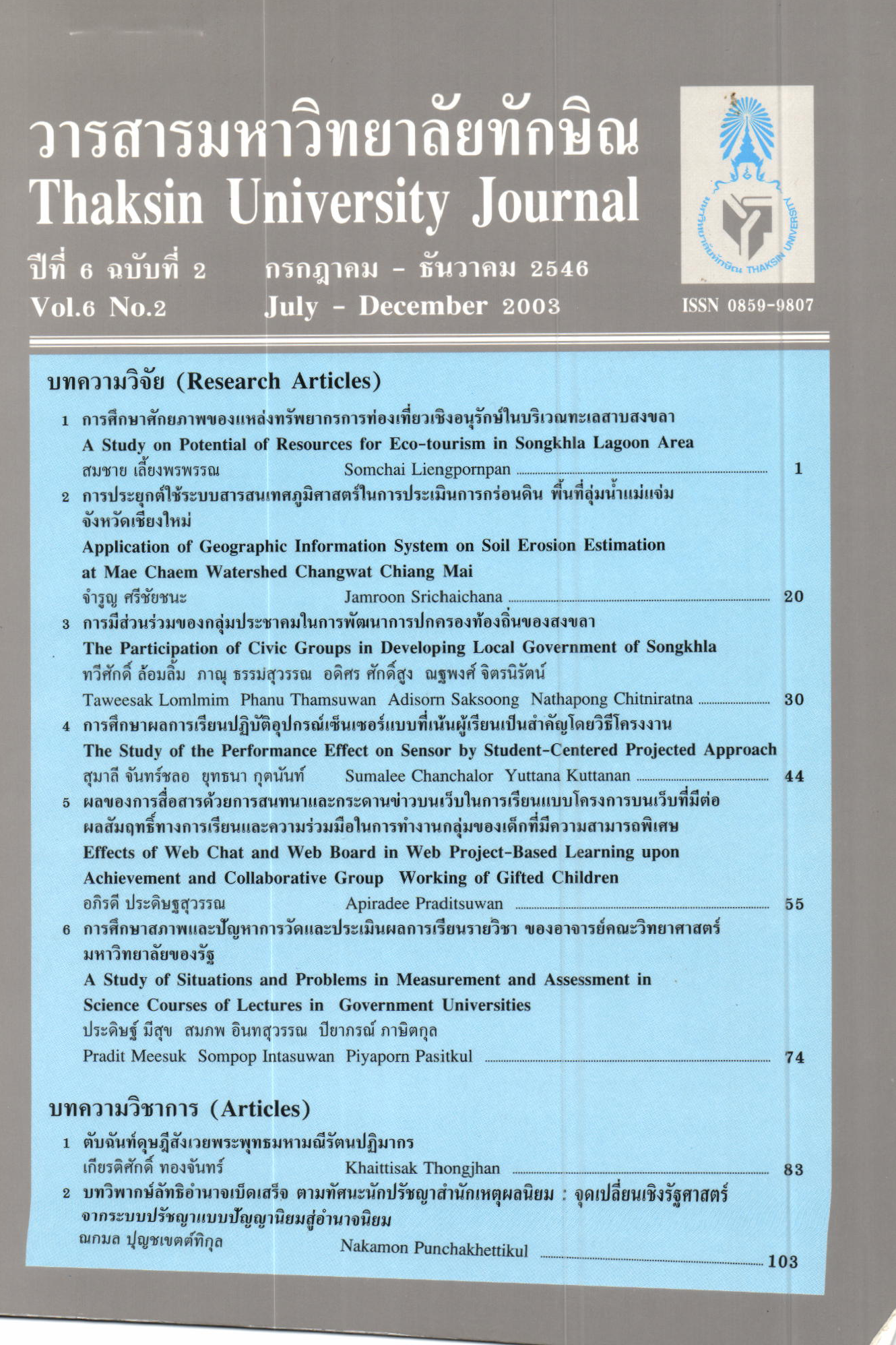การศึกษาศักยภาพของแหล่งทรัพยากรการท่องเที่ยวเชิงอนุรักษ์ในบริเวณทะเลสาบสงขลา
Main Article Content
Abstract
The objectives of the study of the potentials of eco-tourist resource sites around The Songkhla Lagoon were:1) to survey and assess the said potentials with reference to ease of access, facilities, environment, value and importance, responsiveness of local people, education, environmental preservation and management agency, 2) to survey and study touristsû desires regarding the sites, and 3) to propose a perspective on the development of eco-tourism around The Songkhla Lagoon. The instruments of the study were: a form for assessment of the said potentials and a questionnaire constructed for data collection at each site and administered to tourists only at the sites which scored 50 per cent and above on potential. Following are the findings of the study.
1. On the basis of the outcome of the assessment of the said potentials of a total of 49 sites, the sites could be divided by level of score on potential into three groups.
1.1 The group at high potential level (scoring 66-80 per cent) consisted of eight sites: Institute for Southern Thai Studies, Lesser Sea Wildlife Sanctuary, National Museum at Songkhla, Songkhla Lagoon Wildlife Sanctuary, Samila Beach, Matchimawasworawihan Monastery, Khian Bang Kaeo Monastery, and Thye Yaw Monastery.
1.2 The group at moderate potential level (scoring 50-65 per cent) consisted of 22 sites: Pa Lilai Monastery, Twin Sea Park, Pa Prem Park, Residence of Phatthalung Governor, Saensuk Beach at Lumpum, Tang Kuan Hill, Phothipattamawas Monastery, Suwankhiri Monastery, Chaeng Monastery, Old Songkhla City at the foot of Daeng Hill, Greater Sea Wildlife Sanctuary, Baw Sup Monastery, Noi Hill, Khao Noi, Wang Monastery, Phatthalung Botanical Garden, Wihan Boek Monastery,
Bang khiat Monastery, Lokaram Monastery, Laem Phaw Monastery, Phupha Boek Monastery, and Siriwannawas Monastery.
1.3 The group at low potential level (scoring less than 50 per cent) consisted of 19 sites: Sala Hua Yang Monastery, Tomb of Moslem Ruler Marhoom, Yang Ngam Monastery, Songkhla City Pillar Shrine, Laem Chak Monastery, Chao Poo Thuat Shrine at Daeng Hill, Mouth-of-Lagoon Fortress at Laem Sye, Soong Ko Yai Monastery, Pa Khom Monastery, Chong Thanon Cape, Cemetery of Na Songkhla family, Tiger-Evading sala, Sathing Maw Pottery Production Site, Kuti Hill Pagoda, Khai Tao Beach, Sala Baw Keng and J.V. Larsen Tomb, Ko See Ko Ha, Laem Pho Community Museum, and Sala Kuang.
2. On the basis of inquiries made of tourists at the sites on high and moderate levels, it was found that the majority of tourists felt that further development was needed regarding the aspects of ease of access, facilities, environment, value and importance, responsiveness of local people and management. 3. For perspective on the development of eco-tourism around The Songkhla Lagoon, the sites should be developed in accordance with their potentials, with community management capabilities and with touristsû desires.
1. On the basis of the outcome of the assessment of the said potentials of a total of 49 sites, the sites could be divided by level of score on potential into three groups.
1.1 The group at high potential level (scoring 66-80 per cent) consisted of eight sites: Institute for Southern Thai Studies, Lesser Sea Wildlife Sanctuary, National Museum at Songkhla, Songkhla Lagoon Wildlife Sanctuary, Samila Beach, Matchimawasworawihan Monastery, Khian Bang Kaeo Monastery, and Thye Yaw Monastery.
1.2 The group at moderate potential level (scoring 50-65 per cent) consisted of 22 sites: Pa Lilai Monastery, Twin Sea Park, Pa Prem Park, Residence of Phatthalung Governor, Saensuk Beach at Lumpum, Tang Kuan Hill, Phothipattamawas Monastery, Suwankhiri Monastery, Chaeng Monastery, Old Songkhla City at the foot of Daeng Hill, Greater Sea Wildlife Sanctuary, Baw Sup Monastery, Noi Hill, Khao Noi, Wang Monastery, Phatthalung Botanical Garden, Wihan Boek Monastery,
Bang khiat Monastery, Lokaram Monastery, Laem Phaw Monastery, Phupha Boek Monastery, and Siriwannawas Monastery.
1.3 The group at low potential level (scoring less than 50 per cent) consisted of 19 sites: Sala Hua Yang Monastery, Tomb of Moslem Ruler Marhoom, Yang Ngam Monastery, Songkhla City Pillar Shrine, Laem Chak Monastery, Chao Poo Thuat Shrine at Daeng Hill, Mouth-of-Lagoon Fortress at Laem Sye, Soong Ko Yai Monastery, Pa Khom Monastery, Chong Thanon Cape, Cemetery of Na Songkhla family, Tiger-Evading sala, Sathing Maw Pottery Production Site, Kuti Hill Pagoda, Khai Tao Beach, Sala Baw Keng and J.V. Larsen Tomb, Ko See Ko Ha, Laem Pho Community Museum, and Sala Kuang.
2. On the basis of inquiries made of tourists at the sites on high and moderate levels, it was found that the majority of tourists felt that further development was needed regarding the aspects of ease of access, facilities, environment, value and importance, responsiveness of local people and management. 3. For perspective on the development of eco-tourism around The Songkhla Lagoon, the sites should be developed in accordance with their potentials, with community management capabilities and with touristsû desires.
Article Details
Section
Research Articles


